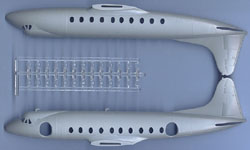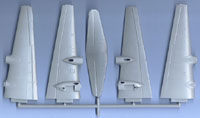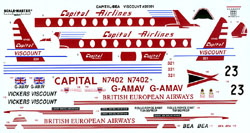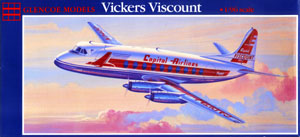Glencoe Models 1/96 Vickers Viscount 700 | | History Immediately following World War II, the apparent advantages of jet power were evident to the aircraft manufacturers. In particular, a turbine-powered airliner could offer great advances in range, capacity and passenger comfort. First off the mark was the British aircraft builder, Vickers, who began development of a 24-passenger aircraft powered by four propeller-turbine engines. By 1946, construction had begun on two prototypes which had been enlarged to accommodate 32 passengers. The first of these, called Viscount 630, was flown on July 16, 1948, and the commercial jet-age was born. The Series 700 Viscount, which is depicted by this model, is an enlarged version with a capacity of 40 passengers and entered the scene in 1950. Among the first operators were Aer Lingus, Air France and Trans Australia. The first North American airline to purchase the Viscount was Trans Canada Airlines, and this was soon followed by Capital Airlines, a large American short haul company.  Public acceptance of the Viscount was immediate and enthusiastic. The plane was fast, quiet and comfortable. And the airlines liked it because it was economical - a real profit maker. There were three versions of the Model 700 Viscount, with variations in fuel capacity, interior arrangements and internal equipment, but externally they were virtually the same. They were powered by four Rolls-Royce Dart turboprop engines giving a maximum cruise speed of 334mph at 20,000 feet. (Quoted from instructions). Public acceptance of the Viscount was immediate and enthusiastic. The plane was fast, quiet and comfortable. And the airlines liked it because it was economical - a real profit maker. There were three versions of the Model 700 Viscount, with variations in fuel capacity, interior arrangements and internal equipment, but externally they were virtually the same. They were powered by four Rolls-Royce Dart turboprop engines giving a maximum cruise speed of 334mph at 20,000 feet. (Quoted from instructions).
The Kit  This newly reissued kit showed up only a couple days before this issue was finished (hence the verbatim history above). This kit has been around for quite a while, though, as it was originally released by Hawk decades ago. I believe that it remains the only injection-molded Viscount out there, and luckily it's a pretty decent kit given its age. The odd scale will make it difficult to fit into an existing collection, although the difference isn't that far off from 1/100, for which there are a few kits of other airliners available. This newly reissued kit showed up only a couple days before this issue was finished (hence the verbatim history above). This kit has been around for quite a while, though, as it was originally released by Hawk decades ago. I believe that it remains the only injection-molded Viscount out there, and luckily it's a pretty decent kit given its age. The odd scale will make it difficult to fit into an existing collection, although the difference isn't that far off from 1/100, for which there are a few kits of other airliners available.
So what do you get in the box? A handful of light gray plastic parts, one sprue of clear parts, a fairly basic instruction sheet, and an outstanding decal sheet. Starting with the plastic, the molds for this kit have held up very well over the years. There's no flash present anywhere, and all the surface detailing is still crisp. The fuselage is split in right and left halves, with separate windows for both the cabin and cockpit. Both left side doors are open, but there's no interior provided so you probably will want to close those doors up. Although if you want to go all out, the kit does include a set of stairs as well, so you could detail out the interior and even have a stewardess walking down the steps.  The wings are split into upper and lower halves, with separate tips. The engine nacelles for the four Rolls-Royce Darts are also split into upper and lower sections, with a separate front intake piece, into which fits the one-piece propeller. The inboard engines also have an extension piece to fit behind the completed nacelle, making it longer than the outboard ones. About the only thing you'll want to think about fixing with the wings would be to thin the trailing edges a bit. The same goes with the stabilizer, which is molded as one piece and is sandwiched between the fuselage halves. The landing gear is surprisingly detailed for a kit of this age, and really only needs some brake lines to really bring them out. The wings are split into upper and lower halves, with separate tips. The engine nacelles for the four Rolls-Royce Darts are also split into upper and lower sections, with a separate front intake piece, into which fits the one-piece propeller. The inboard engines also have an extension piece to fit behind the completed nacelle, making it longer than the outboard ones. About the only thing you'll want to think about fixing with the wings would be to thin the trailing edges a bit. The same goes with the stabilizer, which is molded as one piece and is sandwiched between the fuselage halves. The landing gear is surprisingly detailed for a kit of this age, and really only needs some brake lines to really bring them out.
 The decal sheet is what really shines in this kit, though. Printed by Scale-Master, these are very well printed and provide two choices, one for Capital Airlines and one for British European Airways. Both schemes are natural metal overall with white fuselage tops & vertical fin. The Capital Airlines example has the white come down to just below the fuselage centerline as seen on the boxtop. There's a lot of red on this livery, and all of it is provided in the decal sheet. The British European livery is somewhat more restrained, but just as interesting as the plane depicted took part in the London-New Zealand Air Race in 1953. A high three-line cheat runs The decal sheet is what really shines in this kit, though. Printed by Scale-Master, these are very well printed and provide two choices, one for Capital Airlines and one for British European Airways. Both schemes are natural metal overall with white fuselage tops & vertical fin. The Capital Airlines example has the white come down to just below the fuselage centerline as seen on the boxtop. There's a lot of red on this livery, and all of it is provided in the decal sheet. The British European livery is somewhat more restrained, but just as interesting as the plane depicted took part in the London-New Zealand Air Race in 1953. A high three-line cheat runs  above the windows, while a black number 23 on a white disc is on the tail. Whichever livery you choose you'll want to take your time in putting the decals on, as many are long and thin, but Scale-Master decals have always been simple to apply and there's no reason to think these would be otherwise. above the windows, while a black number 23 on a white disc is on the tail. Whichever livery you choose you'll want to take your time in putting the decals on, as many are long and thin, but Scale-Master decals have always been simple to apply and there's no reason to think these would be otherwise.
Conclusion While it's not in a standard scale, the Glencoe Viscount is still a very nice kit and will build up into a nice model. With the recent availability of Alclad II worldwide this kit will be an excellent platform to experiment with natural metal finishes. My thanks to Glencoe Models for the review sample. | 

 




|
